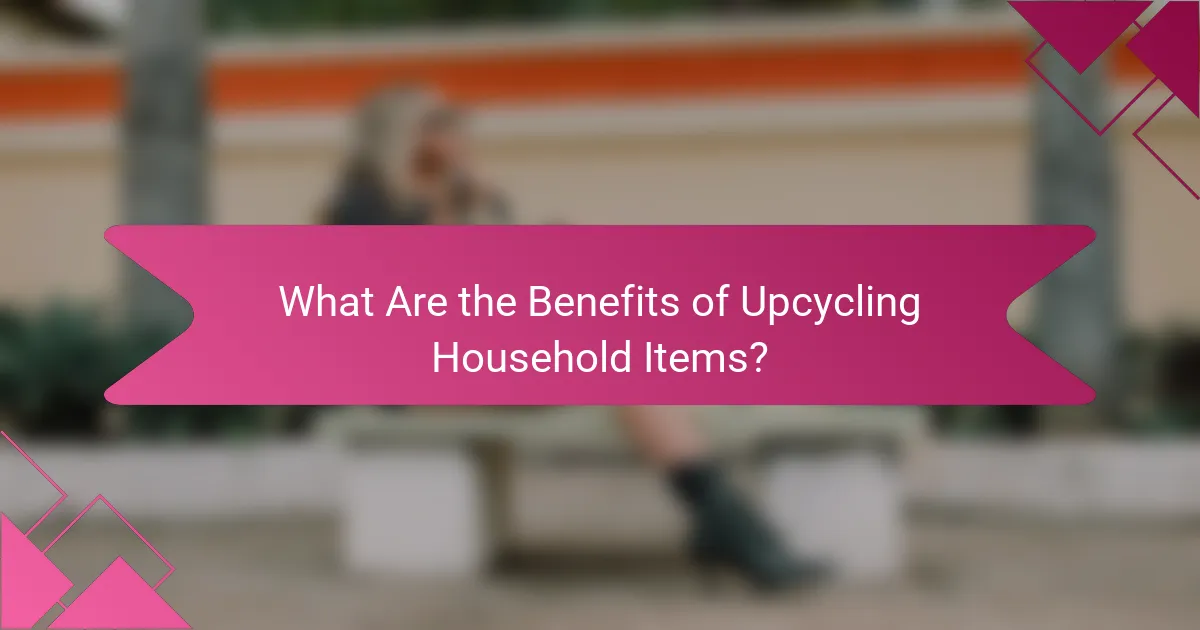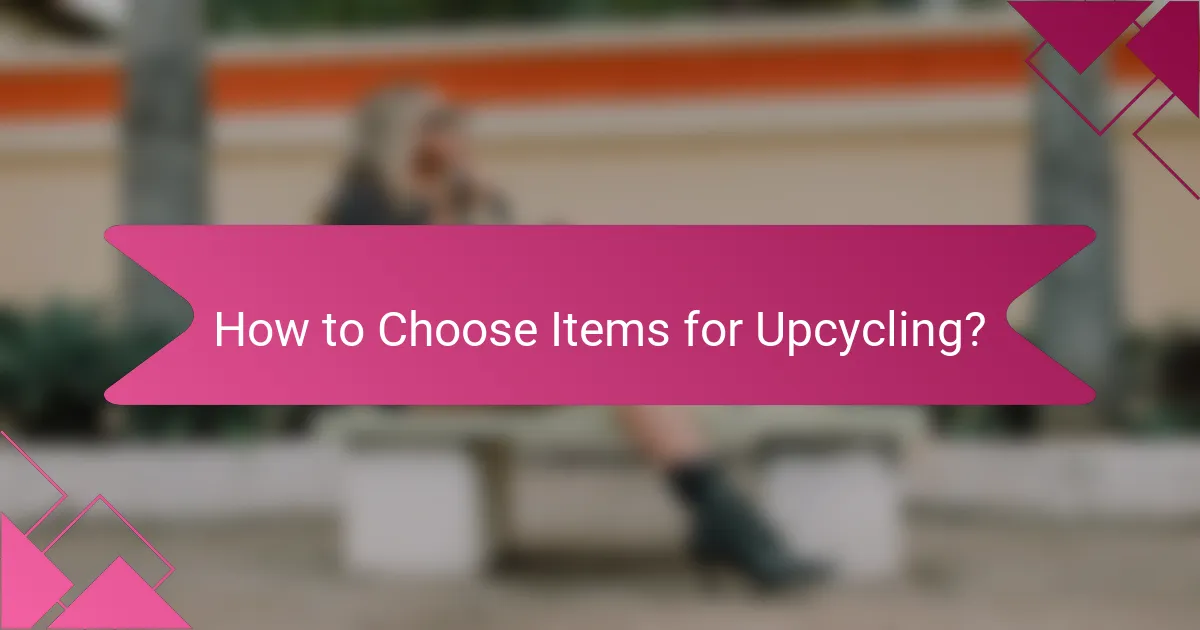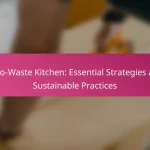Upcycling household items is a creative way to repurpose old or unused objects into functional or decorative pieces, promoting both personal expression and sustainability. This practice not only helps reduce waste but also offers financial savings and fosters creativity. By employing various techniques such as painting, repurposing, and DIY assembly, individuals can transform unwanted items into valuable new products, enhancing their living spaces while contributing to environmental well-being.

What Are Creative Upcycling Ideas for Household Items?
Creative upcycling ideas for household items involve repurposing old or unused items into functional or decorative pieces. This process not only reduces waste but also allows for personal expression and can save money.
Furniture transformation
Transforming furniture is a popular upcycling method that can breathe new life into old pieces. For instance, an outdated dresser can be sanded down and painted to match modern decor, while an old door can be converted into a stylish coffee table. Consider the structural integrity of the furniture before starting, as some items may require additional support or repairs.
When upcycling furniture, choose materials that are safe and suitable for the intended use. For example, using non-toxic paints and finishes ensures a healthier environment, especially in homes with children or pets.
Decorative crafts
Decorative crafts can turn everyday items into unique home accents. For example, glass jars can be transformed into candle holders or vases with a bit of paint and twine. Old fabric scraps can be sewn into decorative cushions or wall hangings.
Consider the aesthetic you want to achieve and select colors and textures that complement your existing decor. Mixing materials can create interesting contrasts, but ensure that they work harmoniously together.
Garden planters
Upcycling items into garden planters is an excellent way to utilize old containers and enhance outdoor spaces. Items like wooden pallets, old tires, or even kitchen colanders can be repurposed into creative planters. Ensure that any container used has proper drainage to prevent waterlogging.
When selecting materials, consider their durability against weather conditions. For instance, metal containers may rust over time, while wooden planters should be treated to resist rot.
Storage solutions
Creating storage solutions through upcycling can help declutter your home while adding character. Old crates can be stacked to form a rustic shelving unit, while repurposed jars can organize small items like screws or buttons. Assess the size and weight capacity of items to ensure they are practical for storage use.
Labeling storage containers can enhance organization and make it easier to find items. Use chalkboard paint or adhesive labels for a customizable approach.
Artistic wall hangings
Artistic wall hangings can be made from a variety of upcycled materials, adding a personal touch to your decor. Items like old frames, fabric remnants, or even discarded wood can be crafted into unique wall art. Consider the theme of your space to guide your design choices.
Experiment with different textures and colors to create depth and interest. Hanging a collection of smaller pieces can create a striking gallery wall effect, making use of what might otherwise be discarded.

What Are the Benefits of Upcycling Household Items?
Upcycling household items offers numerous benefits, including reducing waste, saving money, and fostering creativity. By transforming old or unused items into something new, individuals can contribute to environmental sustainability while enhancing their living spaces.
Environmental impact
Upcycling significantly reduces the amount of waste sent to landfills, which is crucial for environmental health. By repurposing items, you decrease the demand for new products, leading to less resource extraction and lower carbon emissions associated with manufacturing.
For example, turning glass jars into storage containers or using old furniture for DIY projects minimizes environmental footprints. This practice not only conserves resources but also promotes a circular economy where materials are reused rather than discarded.
Cost savings
One of the most immediate benefits of upcycling is the potential for cost savings. By using items you already own, you can avoid purchasing new products, which can be particularly beneficial in today’s economy.
For instance, instead of buying new planters, you can repurpose old buckets or tin cans. This approach allows you to save money while still achieving a fresh look in your home.
Personal creativity
Upcycling encourages personal creativity by allowing individuals to express their unique style. The process of transforming items can lead to innovative designs and solutions that reflect personal tastes.
Engaging in upcycling projects can also be a fun and fulfilling hobby. Whether it’s painting old furniture or sewing fabric scraps into new items, the possibilities are endless, and the results can be deeply satisfying.
Unique home decor
Upcycled items can add a distinctive touch to your home decor, setting your space apart from conventional designs. Each piece tells a story and can serve as a conversation starter.
For example, using an old ladder as a bookshelf or turning wine bottles into light fixtures creates a unique aesthetic. These personalized decor items not only enhance your home but also reflect your commitment to sustainability.

What Techniques Can Be Used for Upcycling?
Upcycling techniques transform unwanted items into new products, enhancing their value and reducing waste. Common methods include painting, repurposing, DIY assembly, and textile reworking, each offering unique creative opportunities.
Painting and refinishing
Painting and refinishing are effective ways to breathe new life into old furniture or decor. A fresh coat of paint can completely change the appearance of an item, while refinishing can restore its original beauty. Consider using eco-friendly paints to minimize environmental impact.
When painting, ensure surfaces are clean and sanded for better adhesion. For refinishing, stripping old finishes may be necessary, which can involve chemicals—always follow safety guidelines. Choose colors that complement your existing decor for a cohesive look.
Repurposing materials
Repurposing materials involves transforming items into something entirely different, maximizing their utility. For example, glass jars can become storage containers or vases, while wooden pallets can be converted into furniture. This technique encourages creativity and resourcefulness.
Before starting a project, assess the condition and suitability of the materials. Ensure that any repurposed items are safe for their new use, especially if they will hold food or be used by children. Keep in mind local regulations regarding safety standards for certain materials.
DIY assembly
DIY assembly combines various materials to create new products, often requiring basic tools and skills. For instance, you can build a garden bench from reclaimed wood or construct a shelf from old crates. This method allows for personalized designs tailored to your space.
Start by gathering necessary tools and materials, and sketch out your design to visualize the final product. Be mindful of structural integrity; ensure that assembled items are sturdy and safe for use. Look for online tutorials for guidance on specific projects.
Textile reworking
Textile reworking involves altering or combining fabrics to create new items, such as turning old clothes into bags or quilts. This technique not only reduces textile waste but also allows for unique, personalized creations. Consider using sewing, weaving, or knotting techniques.
When working with textiles, choose fabrics that complement each other in color and texture. Wash and prepare materials before starting to ensure cleanliness and durability. If you’re new to sewing, start with simple projects to build confidence and skills.

How to Choose Items for Upcycling?
Choosing items for upcycling involves evaluating their condition, potential for transformation, and functionality in new forms. This process ensures that the selected items can be creatively repurposed while serving a practical purpose.
Assessing item condition
Start by examining the physical state of the item. Look for structural integrity, signs of wear, and any damage that may affect its usability. Items that are only slightly worn or damaged can often be upcycled effectively, while those that are severely degraded may not be worth the effort.
Consider the materials used in the item. Wood, metal, and sturdy fabrics are generally good candidates for upcycling, while fragile materials may not hold up well in new applications. A quick inspection can help you determine if the item is salvageable.
Identifying potential
Think creatively about how the item can be transformed. For example, an old ladder can become a bookshelf, while glass jars can be turned into decorative storage containers. The more versatile the item, the greater its potential for innovative upcycling projects.
Research popular upcycling trends to inspire your ideas. Pinterest and DIY blogs often showcase unique transformations that can spark your creativity. Identifying potential means envisioning the item in a new role, so keep an open mind.
Considering functionality
Evaluate how the upcycled item will function in its new form. Will it serve a practical purpose, such as storage or decoration? Ensure that the final product meets a need or enhances your living space. It’s important that the upcycled item is not just visually appealing but also useful.
Think about the ease of use and maintenance of the upcycled item. For instance, if you’re transforming an old chair into a planter, ensure it has proper drainage and is easy to care for. Balancing aesthetics with functionality will lead to successful upcycling outcomes.


